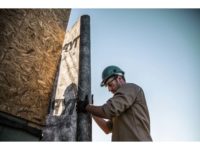New Generation of Building Wraps
Innovative Products Take on Bulk Water Drainage




Among the many performance characteristics we expect of today’s building wraps, draining bulk water is increasingly gaining importance. When rainwater infiltrates the space between cladding and sheathing, it can create major problems if it isn’t managed quickly.
In many areas around the country, building codes are driving the need for better moisture management solutions. The International Residential Code (IRC) requires the use of water-resistive barriers, but some states have added even more prescriptive measures to their codes that now include the use of drainage planes, and others are expected to follow.
Water can find its way into a wall via numerous paths. High humidity and extreme temperatures can cause vapor diffusion when warm indoor air leads to condensation on colder outside surfaces. Reservoir cladding materials such as brick and stucco can absorb and store moisture, which can be driven back into the wall assembly when warmed by the sun. Wind-driven rain can be forced into small openings in the exterior cladding at joints, laps, and utility cutouts. Further, wind blowing around the buildings can create a negative pressure within a wall assembly, siphoning water into the wall.
Thankfully, advances in material technology have resulted in innovative solutions for protecting our homes and buildings from the elements while allowing them to both release vapor buildup and drain bulk water. And with a growing number of products hitting the market to address this need, it’s important to understand how each performs in order to specify the right building wrap for your project.
More Than One Way to Keep a Wall Dry
Drainage is widely accepted as one of the most effective measures for reducing damage due to rain penetration and is a critical component in allowing a building wrap to do its job, particularly in keeping walls dry. Historically, drainage has been achieved through the use of furring strips that separate the wrap from the structural sheathing and framing, but new technologies have emerged that are helping to simplify this process.
Today’s most advanced building wrap products feature integrated drainage gaps through creping, embossing, weaving or filament spacers. These new products eliminate the need for furring strips, helping to reduce material costs and streamline installation.
The drainage efficiency of a building wrap is generally tested in accordance of ASTM E2273. In simple terms, this test involves spraying water onto a wall assembly and measuring its collection over time. However, given the variety of drainable building wraps available, how quickly bulk water is drained can vary significantly. Here’s a look at a few of the methods modern building wraps use to drain water from a wall assembly.
Integrated Rainscreens
One method for achieving bulk water drainage is the integration of a rainscreen material onto the building wrap. These products eliminate the cost and time-consuming labor of installing furring strips by creating a gap between the sheathing and the cladding, which facilitates both drainage and continuous airflow. Where wood strapping only vents approximately 85 percent of the wall, building wraps with an integrated rainscreen provide a continuous vented airspace over the entire surface area of the wall, providing greater drainage and more effective drying. And because many rainscreen products use a matrix of plastic material to achieve the gap, they aren’t subject to saturation and decomposition that could compromise wood furring.
Rainscreen products are recommended in areas with wind-driven rain, high amounts of rainfall (40 to 60 inches annually), or high temperature and humidity. Coastal areas and hilltop exposures are prime examples of when this technology would be ideal. In these situations, the importance of creating a drainage plane is heightened when using an absorptive cladding material like wood or fiber cement.
Wraps with Spacers or Dimples
Another approach gaining in popularity is the incorporation of unique spacers, or dimples, onto the building wrap itself. These drainable building wraps are able to achieve a 1mm drainage gap through a pattern of integrated spacers and can be as much as 100 times more effective than standard building wraps at removing bulk water from the wall. Most can be installed in any direction without affecting performance.
These products are recommended behind wood, fiber cement, vinyl, stone and stucco cladding, or where budgets don’t allow the use of a full rainscreen system.
Integrated Fibrous Layer
The cutting edge of drainable building wrap technology are products that create a drainage gap through an additional layer of polypropylene fibers. TYPAR Drainable Wrap, for example, uses this technology to create a 1 mm drainage gap and has been shown to achieve 94.8 percent drainage efficiency per ASTM E2273 without sacrificing any of the durability and ease of installation benefits builders and contractors have come to expect from premium building wraps, since it essentially handles and installs the same as a standard TYPAR building wrap. In addition, it is backed by an industry-leading lifetime-limited warranty that includes both materials and labor.
Like dimpled wraps, these products can also be installed in any direction without affecting performance. And they are vapor permeable, so moisture will not become trapped in the wall assembly and lead to mold or rot issues.
Making the Right Spec
With so many options to choose from, how do you know what type of weather protection is best for your project? In addition to the scenarios described above, there are a number of factors to consider.
A key consideration is the type of cladding being used. When installing vinyl siding, which has built-in drainage holes and fits loosely on the wall, an ordinary smooth-faced building wrap should provide adequate drainage. However, tightly fastened cladding such as cedar siding or fiber cement board might allow water trapped between the siding and a smooth building wrap to pool and could eventually make its way through the building wrap and into the framing. These are cases where a drainable wrap would provide significant benefit.
Reservoir claddings such as brick, stucco and stone present another set of issues. Because these materials hold water, once they get wet the stored water can migrate elsewhere and cause problems. In these applications, it is imperative to separate the cladding from the rest of the assembly with a capillary break, which can be an airspace or a material that sheds water or does not absorb or pass water.
Geography and climate are important, as well, specifically as it relates to annual rainfall. As a rule of thumb, the Building Enclosure Moisture Management Institute recommends that any area receiving more than 20 inches of annual rainfall should incorporate enhanced drainage techniques, especially if using an absorptive cladding material, while areas receiving 40 inches or more should utilize rainscreen design regardless of cladding material. The geographic orientation of the wall, amount of overhang, altitude, and even nearby trees can also have an impact on how much water intrusion can be expected and how likely it is to dry.
While we can’t completely stop water from getting into walls, advances in building wrap technology are a welcome way to help ensure potential damage from water intrusion is mitigated. And with a variety of drainable products to choose from, each offering a different approach to bulk water drainage, builders and contractors have many ways to keep walls dry in any climate or condition.
Looking for a reprint of this article?
From high-res PDFs to custom plaques, order your copy today!







